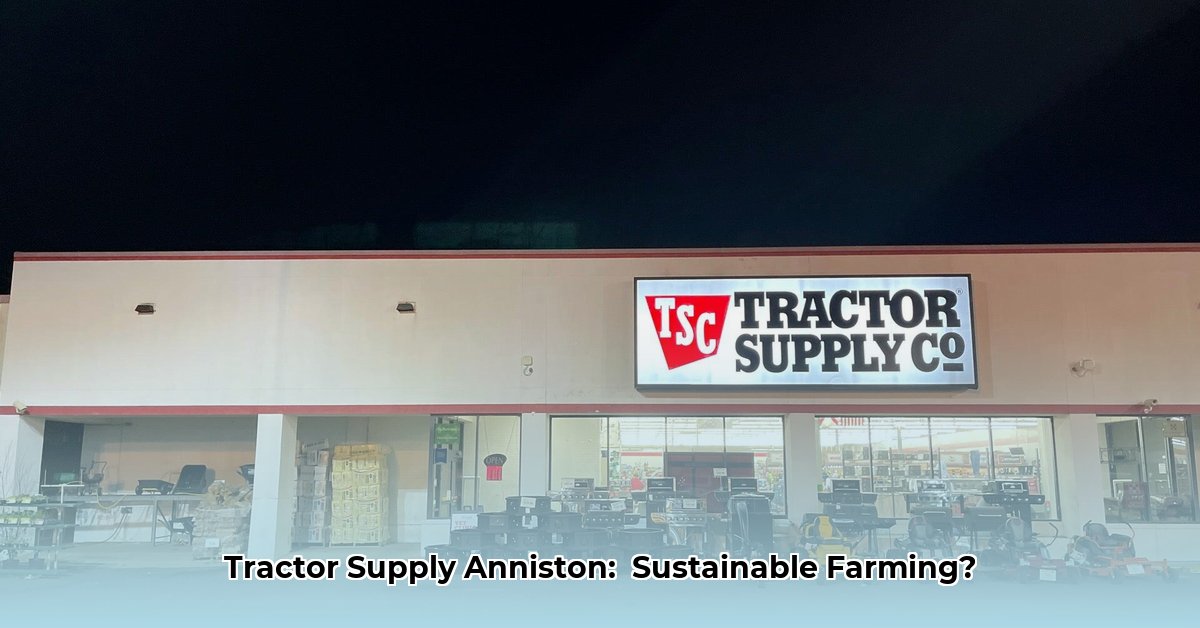
Location, Location, Location: Anniston's Agricultural Landscape
The Tractor Supply Company (TSC) store in Anniston, Alabama, occupies a strategic location near a major retailer like Walmart, suggesting convenient access for a wide customer base, including local farmers. Anniston and its surrounding areas possess a rich agricultural history. Numerous farms characterize the region, and their success is inextricably linked to the accessibility of essential supplies and resources. The store's proximity to these farms makes its role in either supporting or hindering sustainable agricultural practices especially critical. How easily can local farmers obtain the materials necessary for sustainable farming methods? This is a crucial question demanding thorough investigation. A key aspect to consider is the presence of competing agricultural supply stores in the vicinity, and the relative pricing and product offerings they sustain. This competitive landscape shapes the choices available to local farmers.
The Inventory Enigma: Assessing Sustainable Product Availability
A significant hurdle in this analysis is the lack of readily available, detailed information regarding the Anniston TSC store's inventory. While the company website provides the store's location, a comprehensive inventory list remains elusive. This severely hampers the ability to definitively state the volume of sustainable farming products available. The availability of crucial items such as organic seeds, eco-friendly fertilizers, and sustainable pest control options remains unquantified. These are fundamental elements for assessing the store's impact on sustainable agriculture. Further research, potentially through direct communication with store management, surveys of local farmers, and competitor analysis, is needed to create a complete picture.
The Farmer's Perspective: A Balancing Act Between Cost and Sustainability
Even without precise sales data, the broad impacts of TSC's offerings on local farmers are evident. The products available directly influence farmers' choices regarding their farming practices. For example, a farmer aiming to transition to organic seeds might be discouraged if such products are unavailable or excessively costly at their local TSC. This lack of access might necessitate longer travel distances, increasing costs and potentially diminishing the feasibility of the transition. Conversely, the readily available supply of eco-friendly products could empower farmers to embrace greener choices easily. This highlights the direct relationship between product accessibility and the adoption of sustainable farming practices amongst Anniston's agricultural community.
Stakeholder Perspectives: A Collaborative Imperative
The various stakeholders involved and their potential interactions with TSC's actions are as follows:
| Stakeholder | Short-Term Impact | Long-Term Impact |
|---|---|---|
| Local Farmers | Access (or lack thereof) to sustainable supplies directly influences yields and profitability. | Increased access to sustainable products could enhance soil health, reduce environmental impact, and improve long-term profitability. |
| Tractor Supply Anniston | Sales data guides inventory choices. Profitability hinges on meeting customer demand. | Adapting to increased demand for sustainable products could improve brand image, attract new customer segments, and bolster profitability. |
| Regional Sustainability Groups | Limited direct control over TSC's inventory but can influence through advocacy and partnerships. | Potential for collaborative projects to educate farmers, promote sustainable practices, and influence product offerings via collective buying power. |
| Researchers/Academics | Limited data necessitates further research to comprehend TSC's full impact. | Research findings can inform future policies, influence sustainable practices, and aid in developing sustainable product lines. |
Risk Assessment: Identifying Challenges and Opportunities
The following risk assessment matrix illustrates potential setbacks and solutions concerning sustainability at the Anniston TSC:
| Risk Factor | Likelihood | Impact | Mitigation |
|---|---|---|---|
| Limited sustainable product range | Moderately Likely | Moderate | Expand eco-friendly offerings; partner with local suppliers of organic & sustainable products. |
| Supply chain transparency concerns | Very Likely | Moderate | Demand greater transparency in product sourcing; support ethical & sustainable supply chains. |
| Reliance on conventional methods | Very Likely | High | Invest in farmer education programs; incentivize adoption of sustainable techniques. |
| Unsustainable claims (greenwashing) | Moderately Likely | Low | Carefully vet sustainability claims; rely on independent verification of certifications. |
Recommendations for a More Sustainable Future
Promoting sustainable agricultural practices in the Anniston area requires a multi-pronged approach. TSC should conduct thorough inventory analyses and expand sustainable product lines based on local demand. Local farmers should actively provide feedback to TSC regarding their needs. Regional sustainability initiatives can organize educational programs to highlight the benefits of sustainable agriculture. Finally, continued research is crucial to understanding the environmental and economic impact of transitioning to sustainable practices in the Anniston context. Data-driven decision-making will be essential for driving effective and lasting change. The collaboration of these stakeholders is key to fostering a more sustainable agricultural ecosystem in Anniston.